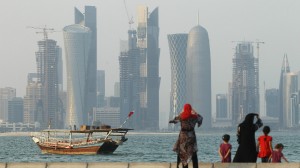
A new study warns that booming places along the Persian Gulf, such Doha, Qatar, could be lethal to humans by 2100 because of excessive heat.
We frequently hear of the future dangers that human-caused climate change could bring, but few paint as bleak a picture as the one laid in a new study released this week.
The study by authors from Loyola Marymount University and the Massachusetts Institute of Technology offers a harsh assessment: Climate change could leave major cities in a key part of the Middle East, the oil-rich Persian Gulf region, unfit for humans to survive.
They’d literally be unlivable.
And not because far off glaciers are melting and raising the sea level or because storms are becoming stronger or more frequent. They’d be unlivable simply because it is becoming too dang hot during the summer.
Two Degrees: Have a climate change question? Ask it here
It makes sense that as global temperatures continue to rise as a result of greenhouse gas emissions by humans (and creep ever closer to the all-important 2 degree Celsius of warming), areas such as the Persian Gulf, which already experience some of the most extreme temperatures on Earth, would be the first to reach a level where humans can no longer survive.
That leaves a region that relies so heavily on the extraction of fossil fuels for its economic prosperity potentially rendered uninhabitable because of their use.
Sweating it out — or not
“It’s not the heat, it’s the humidity.”
We’ve all heard this statement, and as a Georgia resident, I can attest to its truthfulness. It’s especially valid when it comes to the human body’s ability to deal with heat stress.
Our bodies react to heat by producing sweat, which then evaporates and cools our skin by a process known as evaporative cooling. But as the temperature and moisture in the air increase, that process becomes less and less effective. It can reach a point where a body can no longer cool off.
The study looked at “wet-bulb temperature,” which is a value that combines air temperature and humidity. Wet-bulb temperature is always less than the actual air temperature, unless the air is 100% saturated, with drier air having a lower wet-bulb temperature compared with the air temperature.
CNN
 Q FM Africa's Modern Radio
Q FM Africa's Modern Radio